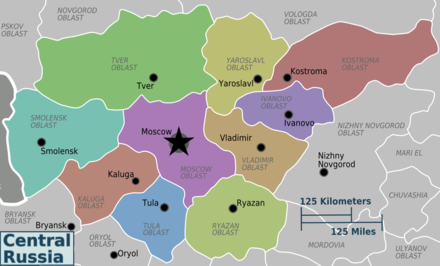
Central Russia is in the country's extreme west, but it casts the main role in Russian history and economics. Pioneer cities were established here more than 1000 years ago. During its feudal disunity this territory took the main impact of the Tartar Yoke, started in 13th century and lasted for two hundred years. Central Russia is that core area, which formed around Moscow Princedom when in 15th century it started to collect Russian feudal lands into a back single state to throw down the Tartars. That was the only period, when this region was the geographical center of Russia.
Later on, Central Russia continued to be the core of the country, proving its name for at least 700 years. 3 major battles in Russian history hit this region in 1380, 1812 and 1941. Many of famous Russians were born and lived there, including Lev Tolstoy, Anton Chekhov, Sergey Yesenin, Yuri Gagarin and others.
Nowadays, this tiny part of Russian territory (2.5%) concentrates about 20% of the population and plays the lead role in the country's economy and politics. The region feels the tremendous influence of Moscow metropolitan area, which pumps out human and financial resources from neighboring regions. This leads to significant dispatities between the capital and other cities, those are often looking depressive.
Huge tourist potential of Central Russia is only going to be discovered. International tourists usually visit the metropolis of Moscow, less frequently see the historic legacy of the Golden Ring, and often undeservedly skip hidden, but awesome corners of this region.
Regions
[edit]
| The Federal City of Moscow The capital of Russia, its economic and political center with 860-years history. With its 13.2 million population, Moscow is the largest metropolitan area not only in Russia, but also in Europe (more populated than Greater London and Paris). Reasonably, Moscow has numerous attractions for tourists. |
| Moscow Oblast Densely-populated by Russian standards, this is the region surrounding Moscow and containing all its satellite suburbs. Nevertheless, Moscow Oblast has many historical cities and natural sights, those are available for a daily trip from the capital. |
| Ivanovo Oblast |
| Kaluga Oblast |
| Kostroma Oblast |
| Ryazan Oblast |
| Smolensk Oblast |
| Tver Oblast |
| Tula Oblast |
| Vladimir Oblast |
| Yaroslavl Oblast |
Cities
[edit]Other destinations
[edit]- 1 Bogolyubovo — a small village east from Vladimir, a UNESCO World Heritage site for its 12th century white stone monastery and churches.
- Ethnomir (EthnoWorld) — the only tourist ethnic village in Russia. The idea is to model various traditional world cultures at the single place.
- 2 Kulikovo Pole — one of 3 Russian primary battlefields. There, at the south-east of modern Tula Oblast, Prince Dmitry Donskoy's army for the first time defeated the Tartar Horde in 1380.
- 3 Lake Seliger
- 4 Meschera — a vast forested area including parts of Moscow Oblast, Ryazan Oblast and Vladimir Oblast with 2 national parks, numerous amazing lakes and endangered animals habitat.
- 5 Optina Pustyn — a monastery, which in the 19th century was the most important spiritual centre of the Russian Orthodox Church and served as the model for several other monasteries. It was particularly renowned as the centre of Russian staretsdom.
- 6 Plescheevo Ozero National Park
- 7 Prioksko-Terrasny Nature Reserve — a protected forested habitat in the south of Moscow Oblast with the unique bison farm.
- 8 Yasnaya Polyana — the beautiful estate and museum of a famous Russian writer, Leo Tolstoy, located to the south from Tula.
Understand
[edit]Talk
[edit]Within Moscow and at most large tourist sites, it is possible to find English speakers. At major tourist destinations, guides are available in most major world languages. The only language you are likely to hear on a daily basis, however, is Russian, and knowledge of the Cyrillic alphabet plus a few key phrases will certainly make independent travel a lot easier.
Get in
[edit]See Moscow, the point of arrival for the vast majority of the region's visitors.
Get around
[edit]Rail is the most convenient method of public transportation between cities. From Moscow rail stations, there are suburban trains called электрички (eh-lehk-TREECH-kee), which will take you to smaller cities within the region.
See
[edit]The regions most popular sights by far are located within and around Red Square and the historic loop of cities comprising the Golden Ring.
Itineraries
[edit]- Golden Ring — the classic tour of the historically and architecturally rich regions surrounding the capital
- Trans-Siberian Railway — the most popular route begins here, in Moscow
Do
[edit]Eat
[edit]Moscow is home to truly world class dining and some of the most expensive restaurants in the world. Outside of Moscow, choices are more limited and Russian cuisine is more predominant.
Drink
[edit]Stay safe
[edit]Go next
[edit]Central Russia is within easy striking distance of Belarus and Ukraine, both centers of ancient Kievan Rus. One of the world's most fabulous tourist destinations, Saint Petersburg, is just an overnight train ride from Moscow. Moscow is also the starting point for most journeys on the Trans-Siberian Railway, which takes travelers to destinations in the Volga Region, Urals, Siberia, and the Russian Far East, as well as non-Russian destinations such as Mongolia, Pyongyang, and Beijing.


